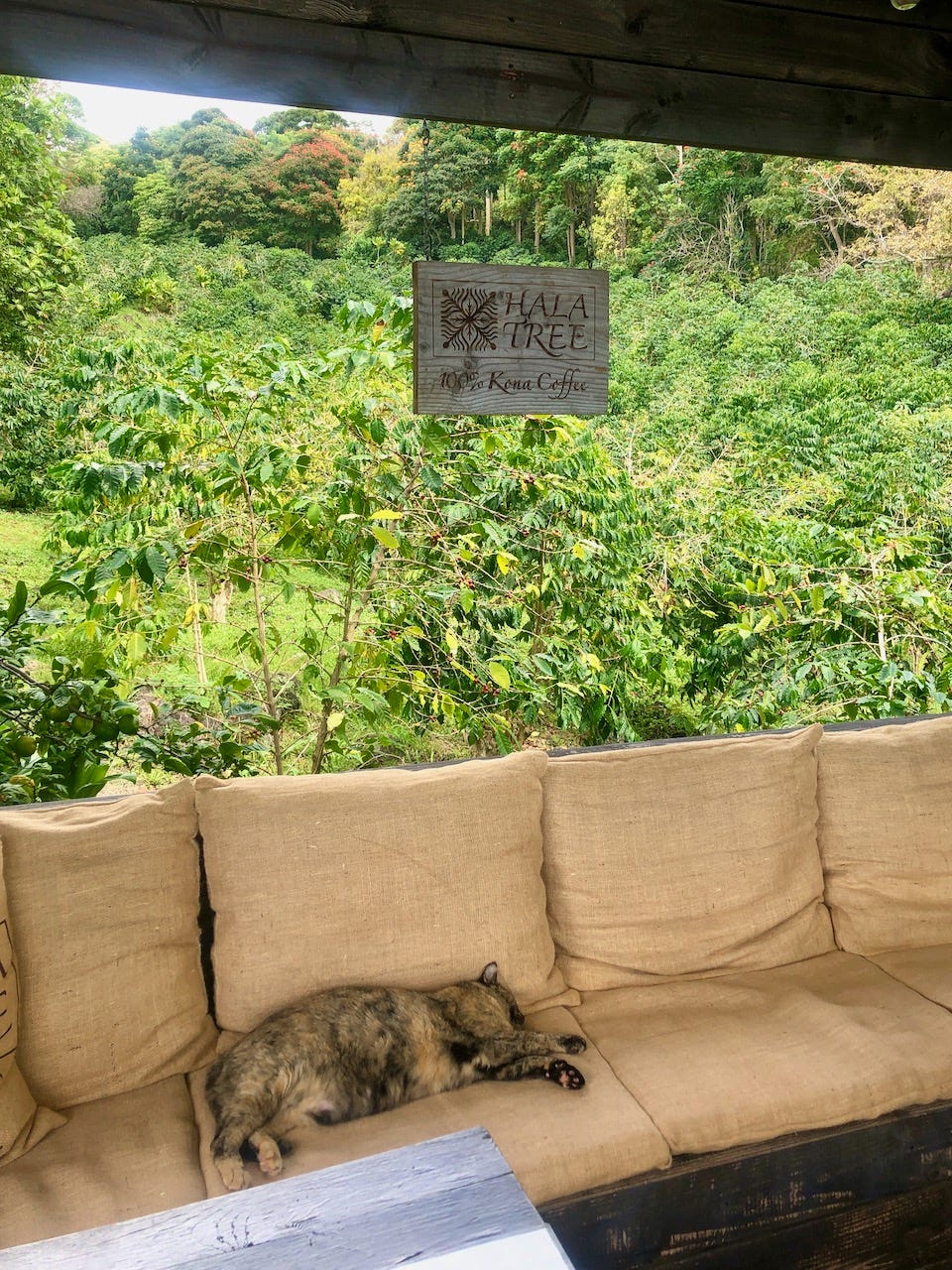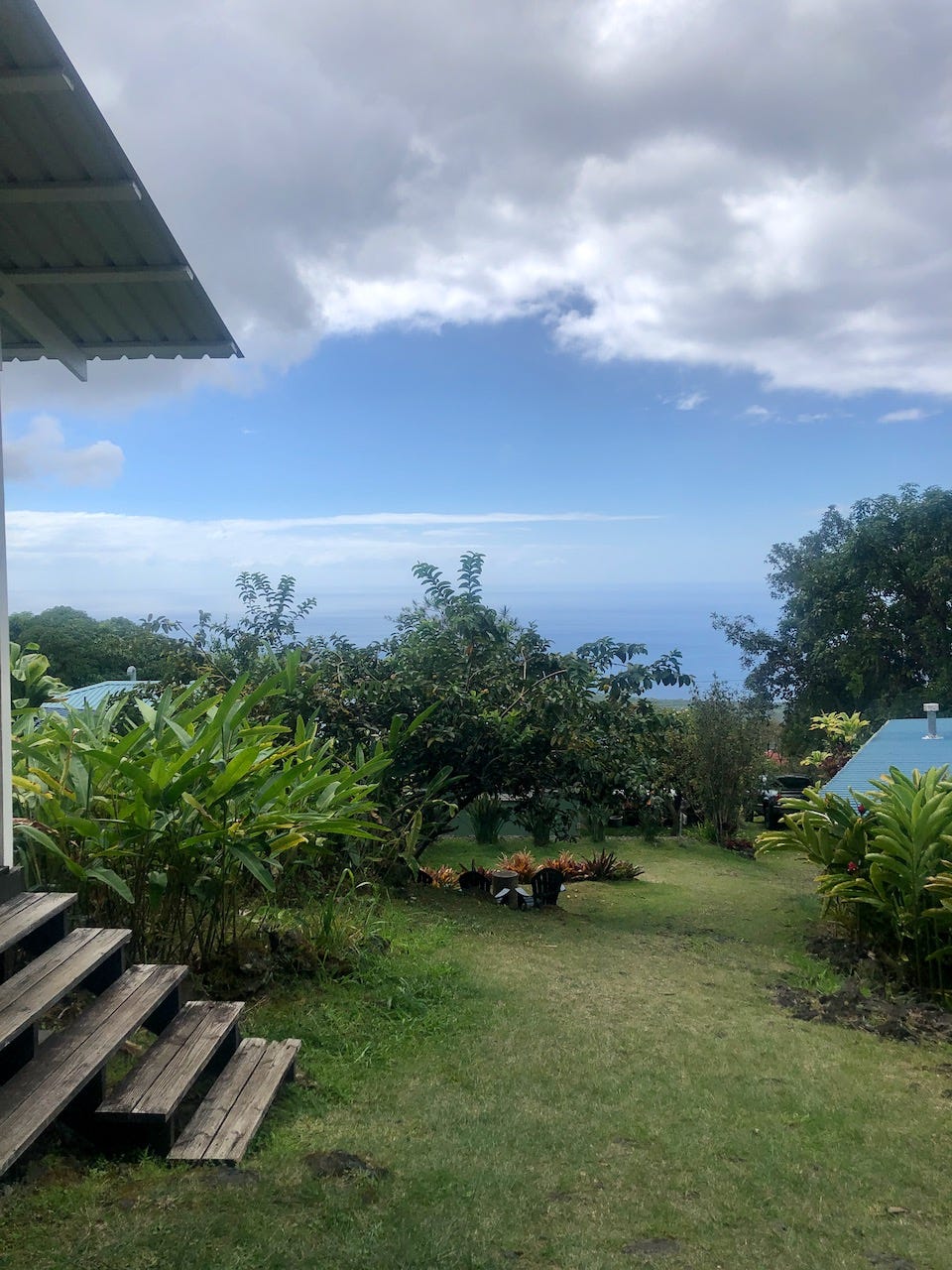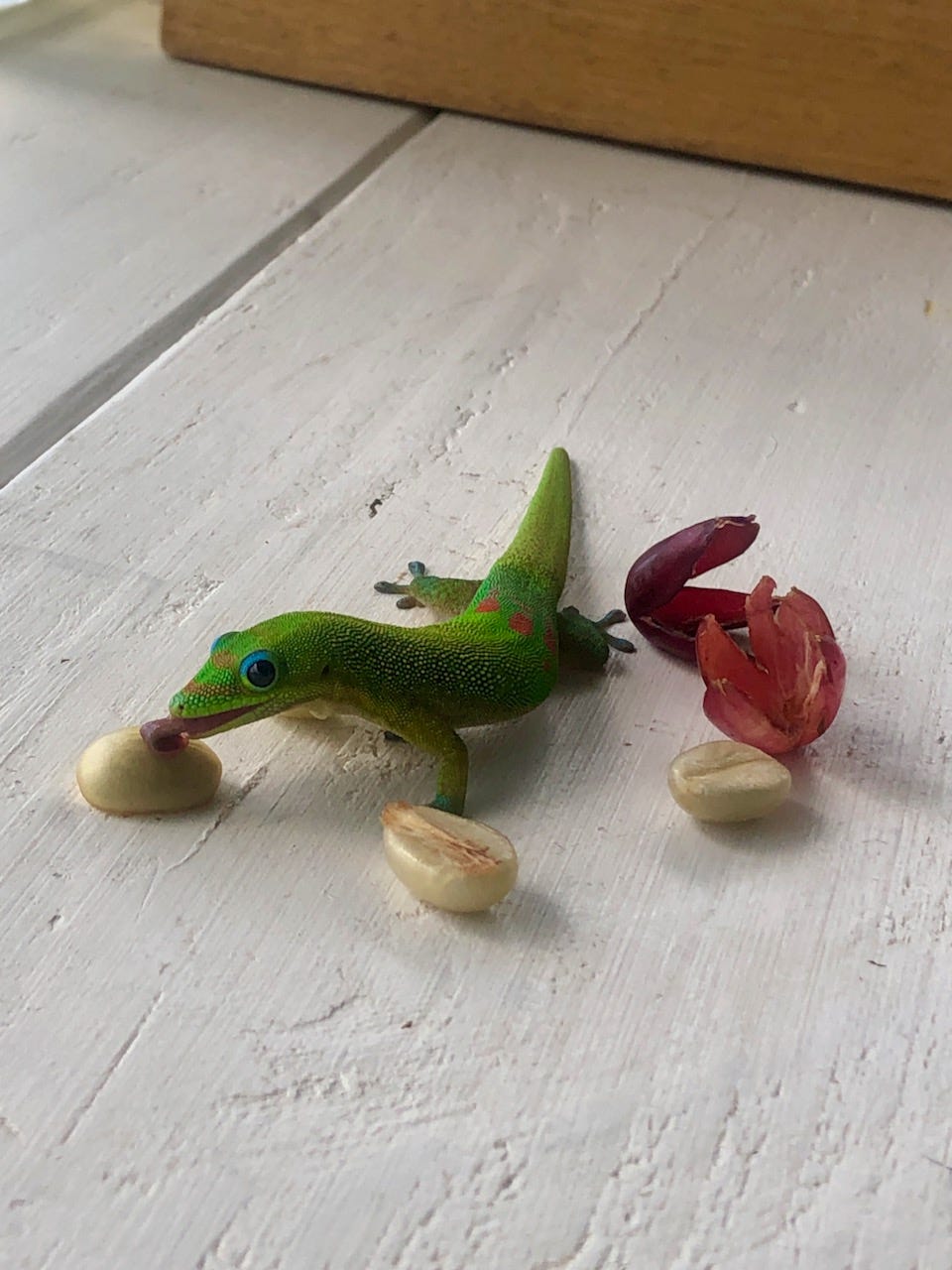Behind The Beans of Kona Coffee
A happenstance Hawaiian coffee tour and what you should know about organic and blend labels
As I waited for the kettle to come to a boil, I surveyed the label of the coffee beans my boyfriend had brought home. Coava Coffee. Washed process. Daurfusu. Timor Leste. Varietal: Typica. Roasted on 11/8/23.
I’m accustomed to reading coffee labels for the tasting notes. But this morning I was looking at it with a different eye, the words describing the origins of the beans standing out to me instead.
Washed process: Ok, that means they washed the mucilage, or white coating, off the beans once they harvested them from the coffee plant. That’s pretty common.1
Daurfusu, Timor Leste, Typica: These are beans from the typica coffee tree, grown in the Eastern Asian country of Timor Leste by the Daurfusu farmers group.
My memory flashed back to a couple weeks ago, when I stood atop a grassy hill overlooking a jungle of coffee trees on the Hala Tree Farm on the Big Island of Hawaii. Jean Orlowski, the owner of the farm, was explaining the complexity of the Kona Typica coffee plant.
It was there that I learned just how much goes into growing and labeling coffee beans.
Going into my first trip to Hawaii, I didn’t know much about the food culture on the Big Island, aside from the fact that a couple friends had recommended going on a Kona coffee tour.
Upon hearing this recommendation, I had racked my brain for “Kona coffee” and what I knew about it. My only association with Kona coffee was that it was its own brand, so I thought, and was of a lower tier quality. Living in Portland amidst a high-quality coffee culture, I’m admittedly a bit spoiled and had ignorantly thought “hmm, we’ll see about this Kona coffee stuff."
Spoiler alert—I was wrong.

A Transparent Tour
Shortly upon arriving in Hawaii, we learned that their annual Kona Coffee Festival was taking place while we were there. From what I understood, coffee farms offer tours year round but due to the festival they were happening at a higher frequency and there were some special one-off tours.
My boyfriend and I scanned the list for something that appealed to us and picked the Transparency in Kona Coffee Farming at Hala Tree Coffee. It was there that we were plunged into an incredibly valuable learning experience from the coffee farm owner himself.
As we walked up the grassy drive from the parking space down below, we were greeted by quaint-looking French bistro tables and a few patrons sitting outside of the retail space. A little stressed from being a few minutes late, we were surprised to find that we were the only two people who’d signed up for the transparency tour (versus their regular farm tour). Having no idea what to expect from it, Jean walked us up the hill beyond the building where the coffee trees lived.
With a soundtrack of different birds chirping, surrounded by a gorgeous view of the ocean facing west and a plethora of coffee trees to the east, Jean began telling us about his farm’s practices.
It became immediately clear that being a farmer, no matter your product, is no simple feat. It is a constant balance between legislation and doing what you think is best for the end product.
As consumers we’ve been taught to think that an organic label means the product is higher-quality. We’ve also been conditioned to trust an ingredients label for what it is without thinking critically about it. While some of us read ingredient labels, that doesn’t necessarily tell us the whole story of what is in the item. Coffee beans are a perfect example of that—coffee beans are quite literally just that so there is no need for a detailed ingredient label. But as Jean pointed out, don’t we as the customer have the right to know where the beans come from?
The Purity of a Coffee Bean Blend
Due to climate conditions, Hawaii is the only place in the United States that coffee can be grown and therefore makes up less than 1% of the world’s coffee supply. The Kona region, know as the Kona Coffee Belt, makes up most of this production and is home to 900 farms.

Limited to a region that is only 60 square miles, Kona coffee is rare and thus warrants a higher price. To prove his point, Jean told us that Kona coffee costs $25 per pound, compared to beans from other regions of the world that cost ~$1 per pound.
While you may not know exactly where your beans come from, you’re probably more likely to note if the coffee you’re buying is a blend (much like a fine wine). This is where the ambiguity comes in, particularly with Kona coffee as Jean explained to us.
Currently a coffee can be marketed as the rare Kona coffee if it contains just 10% of beans grown in the region. Local farmers lobbied earlier this year to change the legislation to require at least 51% Kona-grown beans, a bill that is still battling approval. Jean’s take on this? A coffee shouldn’t be allowed the label unless it’s 100% Kona.
I think this is where much of my previous notions about Kona coffee came from. It's not hard to imagine that a coffee containing 10% Kona beans would taste a lot different from 100% Kona beans, and that's without variables in the drying and roasting methods.
This 10%-rule appears to only benefit those large-scale producers who add the bare minimum Kona beans to their blend, slap the Kona label on it, and sell it at Kona prices. As consumers we’re left with widely different products, sometimes at the same price, and a poor or confusing product perception as a result.
I'm inclined to agree with Jean. As the customer I’d like to be able to trust the labeling and know that my dollar is paying for the product I think it is, as well as trust the taste.
The Cryptic Meaning Behind “Organic”
Another label I find to be murky, but generally trust as “better,” was made murkier by Jean’s overview on how it applies to his coffee plants.
The Hala Tree farm has historically held the organic certification, but due to a recent change in legislation they’ve reconsidered. The Kona typica trees are highly susceptible to rust, a pest that can lower the yield at best and kill the plant at worst. As a result, they spray a fungicide on the plants to protect them.
While this fungicide is technically allowed under the US government’s organic certification, it can only be sprayed before the plant is flowering. According to Jean, however, the fungicide is most effective when sprayed on the plant before, during, and after flowering. He explained that the organic rules didn’t make a ton of sense since the tree will absorb the spray at any lifestage, regardless of if there’s flowers.
Therefore he and his farm made the difficult decision to retain their fungicide spraying practices and give up their organic certification. A fine line they could’ve easily skirted, he believes in honesty first and foremost and stands by doing what they believe is best for the integrity of the product, organic labels be damned.
What’s In a Label?
As we sat at a bistro table of our own post-tour, waiting for our miniature French presses to brew our selected tastings, I reflected on everything Jean had just shared with us.
What a responsibility it is to be a farmer! I felt myself having more admiration for farmers and the difficult trade offs they must constantly weigh. I appreciated Jean for his honesty and for putting on such a tour. Looking back, it’s a shame we were the only two on it and that they didn’t wrap this transparency element into their regular farm tour, as I think it’s information all coffee consumers should know.
While it’s obviously not possible to go on a transparency tour for every product we consume on a regular basis, the label might as well be the next best thing.
I think this is why I’ve always found myself drawn to reading product labels. Part marketing, part disclosure to you, the label on a bag of coffee beans, or any food product for that matter, is perhaps the closest connection between you and the farmer.
Back home in Portland a week or so later, it was clear that the tour had stuck with me as I analyzed the Coava coffee label. I now feel more empowered to critically read coffee labels to discern what exactly it is I’m drinking.
How can you be a discerning label reader? I encourage you to start with something you eat or drink on a regular basis. Look at the label of what you have at home and research terms you don’t understand. (I’ll be honest, until writing this post and Googling “Timor Leste,” I had no idea it was a country.)
It might sound like a lot of effort but as history shows, it’s up to us as consumers to seek out the information. Look at labels with a critical eye and know what product you are buying. Ask questions when you don’t know the answer.
Jean said it best, after all—it’s ultimately up to you, the consumer, to deem what tastes good and what price you’ll pay for the product. Just make sure you know what you’re paying for.
A natural coffee, on the other hand, means the beans were left to dry entirely in the fruit, while honey coffees are extracted from their fruit and dried with their mucilage in tact, making them sweeter.









